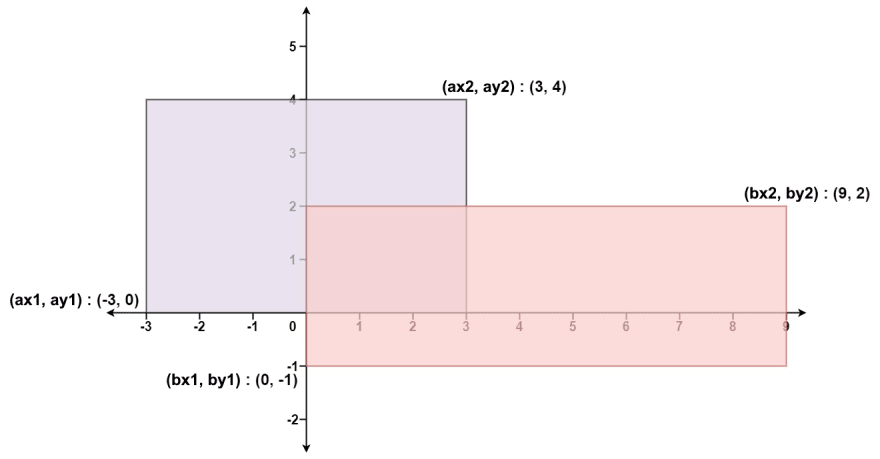An Interest In:
Web News this Week
- April 25, 2024
- April 24, 2024
- April 23, 2024
- April 22, 2024
- April 21, 2024
- April 20, 2024
- April 19, 2024
LeetCode - Rectangle Area
Problem statement
Given the coordinates of two rectilinear rectangles in a 2D plane, return the total area covered by the two rectangles.
The first rectangle is defined by its bottom-left corner (ax1, ay1) and its top-right corner (ax2, ay2).
The second rectangle is defined by its bottom-left corner (bx1, by1) and its top-right corner (bx2, by2).
Problem statement taken from: https://leetcode.com/problems/rectangle-area
Example 1:
Input: ax1 = -3, ay1 = 0, ax2 = 3, ay2 = 4, bx1 = 0, by1 = -1, bx2 = 9, by2 = 2Output: 45Example 2:
Input: ax1 = -2, ay1 = -2, ax2 = 2, ay2 = 2, bx1 = -2, by1 = -2, bx2 = 2, by2 = 2Output: 16Constraints:
- -10^4 <= ax1 <= ax2 <= 10^4- -10^4 <= ay1 <= ay2 <= 10^4- -10^4 <= bx1 <= bx2 <= 10^4- -10^4 <= by1 <= by2 <= 10^4Explanation
The solution to this problem is straightforward. We need to use the school mathematical concept to get the area of two rectangles.
area = Area of rectangle 1 + Area of rectangle 2 - Area of intersecting portionTo calculate the area of intersecting part, we need to compute below four coordinates:
maxCommonX = max(ax1, bx1)maxCommonY = max(ay1, by1)minCommonX = min(ax2, bx2)minCommonY = min(ay2, by2)commonArea = (minCommonX - maxCommonX) * (minCommonY - maxCommonY)Let's check the algorithm.
// compute the area of rectangles using L * H- set area1 = (ax2 - ax1) * (ay2 - ay1) set area2 = (bx2 - by1) * (by2 - by1)// if the rectangles do not intersect, return area1 + area2- if bx1 >= ax2 || bx2 <= ax1 || by1 >= ay2 || by2 <= ay1 - return area1 + area2- set maxCommonX = max(ax1, bx1) set maxCommonY = max(ay1, by1)- set minCommonX = min(ax2, bx2) set minCommonY = min(ay2, by2)- return area1 + area2 - (minCommonX - maxCommonX) * (minCommonY - maxCommonY);Let's check our algorithm in C++, Golang, and Javascript.
C++ solution
class Solution {public: int computeArea(int ax1, int ay1, int ax2, int ay2, int bx1, int by1, int bx2, int by2) { int area1 = (ax2 - ax1) * (ay2 - ay1); int area2 = (bx2 - bx1) * (by2 - by1); if(bx1 >= ax2 || bx2 <= ax1 || by1 >= ay2 || by2 <= ay1) { return area1 + area2; } int maxCommonX = max(ax1, bx1); int maxCommonY = max(ay1, by1); int minCommonX = min(ax2, bx2); int minCommonY = min(ay2, by2); return area1 + area2 - (minCommonX - maxCommonX) * (minCommonY - maxCommonY); }};Golang solution
func computeArea(ax1 int, ay1 int, ax2 int, ay2 int, bx1 int, by1 int, bx2 int, by2 int) int { area1 := (ax2 - ax1) * (ay2 - ay1) area2 := (bx2 - bx1) * (by2 - by1) if bx1 >= ax2 || bx2 <= ax1 || by1 >= ay2 || by2 <= ay1 { return area1 + area2; } maxCommonX := max(ax1, bx1) maxCommonY := max(ay1, by1) minCommonX := min(ax2, bx2) minCommonY := min(ay2, by2) return area1 + area2 - (minCommonX - maxCommonX) * (minCommonY - maxCommonY)}func max(a, b int) int { if a > b { return a } return b}func min(a, b int) int { if a < b { return a } return b}Javascript solution
var computeArea = function(ax1, ay1, ax2, ay2, bx1, by1, bx2, by2) { let area1 = (ax2 - ax1) * (ay2 - ay1); let area2 = (bx2 - bx1) * (by2 - by1); if(bx1 >= ax2 || bx2 <= ax1 || by1 >= ay2 || by2 <= ay1) { return area1 + area2; } let maxCommonX = Math.max(ax1, bx1); let maxCommonY = Math.max(ay1, by1); let minCommonX = Math.min(ax2, bx2); let minCommonY = Math.min(ay2, by2); return area1 + area2 - (minCommonX - maxCommonX) * (minCommonY - maxCommonY) ;};Let's dry-run our algorithm for Example 1.
Input: ax1 = -3, ay1 = 0, ax2 = 3, ay2 = 4, bx1 = 0, by1 = -1, bx2 = 9, by2 = 2Step 1: area1 = (ax2 - ax1) * (ay2 - ay1) = (3 - -3) * (4 - 0) = 6 * 4 = 24 area2 = (bx2 - bx1) * (by2 - by1) = (9 - 0) * (2 - -1) = 9 * 3 = 27Step 2: if bx1 >= ax2 || bx2 <= ax1 || by1 >= ay2 || by2 <= ay1 0 >= 3 || 9 <= -3 || -1 >= 4 || 2 <= 0 falseStep 3: maxCommonX = max(ax1, bx1) = max(-3, 0) = 0 maxCommonY = max(ay1, by1) = max(0, -1) = 0Step 4: minCommonX = min(ax2, bx2) = min(3, 9) = 3 minCommonY = min(ay2, by2) = min(4, 2) = 2Step 5: return area1 + area2 - (minCommonX - maxCommonX) * (minCommonY - maxCommonY) 24 + 27 - (3 - 0) * (2 - 0) 51 - 3*2 51 - 6 45We return the answer as 45.Original Link: https://dev.to/_alkesh26/leetcode-rectangle-area-34ao
Dev To
 An online community for sharing and discovering great ideas, having debates, and making friends
An online community for sharing and discovering great ideas, having debates, and making friendsMore About this Source Visit Dev To


